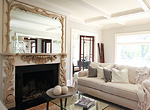Renovation devotee Nicole Curtis restores timeworn homes to their former glory.
By Beth Rutledge
Nicole Curtis is the star of Rehab Addict on the DIY Network and HGTV. The show features old houses in serious need of rescue and repair. Curtis strives to take these properties beyond livable and back to beautiful.
STIR sat down with Curtis, in a fitting setting: an 1882 two-story home. She entered with the same energy her viewers see when she’s on the hunt for the perfect antique light fixture. Focused and upbeat, she surveys her surroundings and wonders aloud what the house looked like when it was built.
STIR: On your show, you work exclusively on old houses. Why?
NC: New houses aren’t intriguing to me at all. I like them old and messy.

STIR: What do you find particularly rewarding about reviving older homes?
NC: I feel like I’m walking in the footsteps of whoever built the home. Lots of people will do bits and pieces to try to fix or improve, but I like to try to tune into what the builder was thinking and keep going with that. As for what’s rewarding, there’s always a moment when the house is finished, when I step back and feel proud. It’s satisfying to make a house ready to be lived in and respected again.
STIR: Are there any homeowner “improvements” that you find particularly hard to fix?
NC: Open floor plans. They are trendy, and they’re usually the result of someone taking out a lot of character, like doorways or room dividers. Leave in the swinging doors and trim!
STIR: Does that mean you’ve developed some self-imposed rules about what you will or won’t do to a home?
NC: I absolutely refuse to put granite countertops in a house. I don’t want to follow trends. Even if I see it already there, I won’t put granite in the house. I need to stick with the home’s original style.

STIR: How does that approach translate to the materials and finishes you choose?
NC: It’s easy to be dazzled by what’s shiny and new, but what’s trendy often won’t stand the test of time. If materials are classic, they’ll go with new appliances and all kinds of décor over the years. My go-tos are hex tile; subway tile; original fixtures; soft, appealing colors; and stained woodwork. And I use salvage whenever possible: cabinets, hardwood floors, doors — if it’s old and cast aside, I’ll try to use it.
STIR: In general, what are some of your favorite vintage architectural elements?
NC: Woodwork is my all-time favorite thing. A fireplace or staircase alone will inspire me to buy a place.
STIR: And specifically? Are there any elements from past projects that strike you as memorable?
NC: All my houses have something memorable. But I am always amazed by leaded glass, stained glass and tile work in old homes. A lot of times people don’t know what a special thing they have — they take a sledgehammer to it. But people who love old homes understand that when the craftsmanship or materials are already there, that house is going to shine. Elbow grease and paint can work wonders.
STIR: Interior painting seems to come last on your projects. At what point do you make decisions about color?
NC: Paint is the easiest, most economical way to transform a space. For a modest investment, you can completely change a room. But I don’t plan too far ahead about colors. I know what works with natural or painted woodwork. I choose light, calm colors because they let the house’s details speak for themselves.

STIR: How do your color palettes highlight woodwork or architectural accents?
NC: There’s a painted fireplace mantel in one of my houses that is hand-carved, and it was basically one color. Just adding a soft white made the carvings stand out. The thing is, these homes want to be peaceful. They’ve had it rough over the years. That’s one of the reasons I prefer a calming, cool color palette.

STIR: Do you have a favorite Sherwin-Williams color?
NC: My favorite has always been Jogging Path (SW 7638). I use that color everywhere — bathrooms, bedrooms, home offices. Sometimes people describe it as sage, but it looks different in every room. It can also have a tan tone; it depends on the light.
STIR: You are self-trained, but you’ve said you have learned a great deal from contractors and design professionals. What’s the most valuable lesson you’ve learned from industry pros?
NC: Ask! I pick the brains of the guys and gals working in my Sherwin-Williams store, and I always learn something. I’ve gotten great tips about primers and how to prep surfaces. They work with this stuff every day, so they know about sheen, quality, texture, technique. If you take 20 minutes to talk to a Sherwin-Williams professional, it’ll change how you work.








